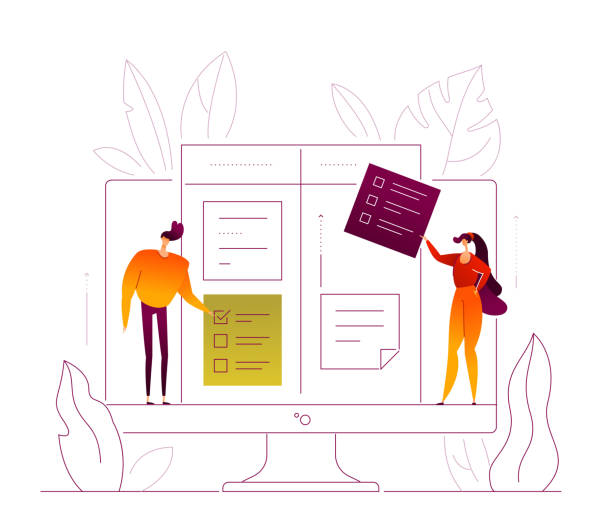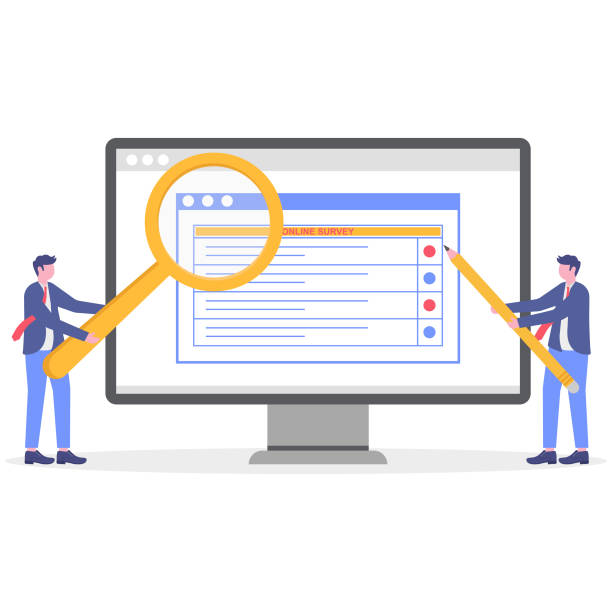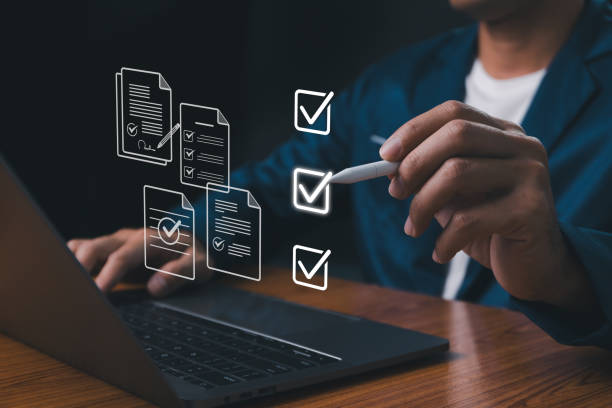1. Why Secure Website Design is Crucial

Secure website design is no longer a luxury option, but an indispensable #necessity for every business and individual with an online presence.
In today’s world, where cyber threats are becoming more complex and widespread every day, website security means protecting #user information, #brand_reputation, and the stability of your business operations.
An insecure website can lead to the loss of sensitive data, malware attacks, identity theft, and even a complete halt to online activities.
The consequences of a security breach are not limited to financial losses; they can also lead to #serious_damage to customer trust and your brand’s reputation.
This section explains and educates on the importance of secure website design and introduces the basic foundations of protection against digital risks.
The goal is to create a proper understanding of the existing risks and the need for a proactive approach in #website_security_provision.
In the information age, any flaw in #web_security can have irreparable consequences.
The loss of customer data, such as banking or personal information, not only leads to heavy legal penalties but can also destroy a company’s reputation forever.
This is especially critical for businesses that conduct online transactions or store sensitive information.
For this reason, planning for secure website design should begin from the initial stages of website development, not just after launch.
Ignoring this issue can lead to system misuse, injection of malicious code, or unauthorized access to servers.
This applies not only to large and corporate websites but also to personal blogs and small sites, which are equally at risk.
Tired of losing business opportunities due to not having a professional corporate website?
RasaWeb, with its professional corporate website design, helps you:
✅ Build a powerful and reliable image for your brand
✅ Convert site visitors into loyal customers
⚡ Get a free consultation now!
2. Common Vulnerabilities and How to Identify Them

Familiarity with weaknesses is the first step in #secure_website_design.
#Cyber_attacks such as SQL injection, XSS (Cross-Site Scripting), CSRF (Cross-Site Request Forgery), and Brute Force attacks are among the most common threats that websites face.
SQL injection allows attackers to gain access to the database by inserting malicious code into input forms.
XSS enables the injection of client-side scripts, which can lead to the theft of cookies or session information.
CSRF also allows an attacker to send unwanted requests to the website through a victim.
This section specializes in and analyzes these vulnerabilities, explaining methods for identifying them.
Automated security scanning tools, manual penetration testing, and code review are among the approaches used to identify these weaknesses.
Understanding how these attacks work and identifying potential entry points is essential for creating a secure website.
Precise knowledge of these vulnerabilities and learning how to identify them is the cornerstone of any successful #site_security strategy.
Failure to address these issues can lead to serious problems and widespread security breaches.
3. The Role of SSL/TLS Certificates and HTTPS Protocol

HTTPS protocol (Hypertext Transfer Protocol Secure) and SSL/TLS certificates form the backbone of #secure_website_design.
This protocol encrypts the communication between the user’s browser and the website server, preventing eavesdropping, tampering, or forging of information during transmission.
Using HTTPS is not only essential for protecting sensitive information such as passwords and credit card numbers but is also a significant factor in improving SEO ranking.
Browsers flag websites without HTTPS as insecure, which can lead to reduced user trust and conversion rates.
This section specializes in and guides on the importance of proper SSL/TLS deployment and configuration.
Installing a valid certificate from a Certificate Authority (CA) and ensuring all traffic is directed to HTTPS are key steps in this process.
Furthermore, regular maintenance and updates of certificates are crucial for maintaining web security.
Without this initial layer of protection, any effort for secure website design will be incomplete, and the website will remain vulnerable to cyber attacks.
SSL certificates not only encrypt information but also verify the website’s identity, assuring users they are connected to the genuine website.
Comparison of HTTP and HTTPS
| Feature | HTTP | HTTPS |
|---|---|---|
| Protocol | HTTP | HTTP + SSL/TLS |
| Encryption | None | Yes |
| Default Port | 80 | 443 |
| Data Security | Low | High |
| Impact on SEO | Negative | Positive |
4. Secure Coding Principles and Best Practices

Secure coding is the core of #secure_website_design.
Common programming errors can lead to vulnerabilities that attackers exploit.
Using #rigorous_input_validation to prevent attacks such as SQL injection and XSS is of high importance.
All data received from the user must be filtered and sanitized before use.
Also, using Prepared Statements when working with the database is an effective solution to prevent SQL injection.
This section educates and specializes in introducing best coding practices.
Proper error and log management, regular updates of libraries and frameworks, and adhering to the Principle of Least Privilege in access allocation are other important points to consider.
Developers should receive necessary training in cybersecurity and use static and dynamic code analysis tools to identify vulnerabilities in the early stages of development.
The OWASP Top 10 project is an excellent resource for learning about the most common web security risks and how to mitigate them.
Adhering to these principles helps developers create a #secure_and_stable_website and prevent many common attacks.
Do you dream of a thriving online store but don’t know where to start?
RasaWeb is your comprehensive e-commerce website design solution.
✅ Attractive and user-friendly design
✅ Increased sales and revenue⚡ Get a free consultation
5. Database Security: Protecting Sensitive Information

The database is the beating heart of many websites, containing vital user and business information.
Therefore, #database_security is considered one of the most important aspects of #secure_website_design.
Encrypting sensitive information in the database, especially financial and personal data, is a fundamental measure.
Even in the event of a successful breach, attackers will have access to unusable data.
Using strong and unique passwords for database access and changing them periodically is also essential.
Additionally, restricting database access only to authorized IP addresses and using database firewalls adds more layers of security.
This section specializes in and guides on comprehensive strategies for database protection.
Regular and secure data backups, implementation of intrusion detection mechanisms, and reviewing database logs to identify suspicious activities are other important aspects.
Ensuring that web applications use secure and parameterized connections for interacting with the database prevents SQL injection attacks.
Ignoring database security can lead to catastrophic data breaches with severe financial and reputational consequences.
Therefore, any approach to website protection must include a robust database strategy.
6. Secure Authentication and Authorization

Authentication and Authorization are two key concepts in #secure_website_design that determine who can access the website and what actions they can perform.
Implementing strong authentication methods, such as #two-factor_authentication (2FA) or multi-factor authentication (MFA), is highly recommended.
These methods add an extra layer of security, preventing unauthorized access even if a password is compromised.
Using hashed and salted passwords instead of storing plain-text passwords is a critical security standard.
This section educates and explains best practices in this area.
Secure Session Management, ensuring proper validation of session tokens, and invalidating sessions after a specified period or inactivity, are other important points.
Furthermore, the authorization system should be designed based on roles (Role-Based Access Control), so that each user only has access to the resources and functionalities necessary for their tasks.
This principle of least privilege helps reduce the attack surface.
Without a strong authentication and authorization system, even the best secure website design measures may be ineffective, opening the door for internal or external attacks.
7. Regular Security Audits and Penetration Testing

Penetration Testing and Security Audits are proactive approaches to identify vulnerabilities before attackers discover them.
These processes involve simulating real cyber attacks on the website by security specialists or automated tools.
The goal is to identify and address security weaknesses in infrastructure, applications, and configurations before they can be exploited.
Penetration testing helps gain a comprehensive view of the website’s security posture and determine necessary actions for #web_security improvement.
This section reports and analyzes the importance of these audits and the best timing for conducting them.
Performing penetration tests regularly, especially after any major changes to the website or infrastructure, is crucial for maintaining a high level of secure website design.
These audits also include reviewing compliance with security standards, access policies, and incident response procedures.
Reports from penetration testing can help the development team quickly address deficiencies and continuously improve #website_security_provision.
These preventive measures are an important part of a comprehensive cybersecurity strategy.
Difference between Security Audit and Penetration Test
| Feature | Security Audit | Penetration Test |
|---|---|---|
| Primary Goal | Checking compliance with standards and policies | Simulating attack to find vulnerabilities |
| Methodology | Reviewing documentation, configurations, code | Attempting to penetrate the system |
| Output Type | Comprehensive report on compliance and weaknesses | List of exploitable vulnerabilities |
| Need for Attacker Knowledge | Less | High |
| Frequency | Periodically (e.g., annually) | After major changes or periodically |
8. Protection Against DDoS Attacks and Firewalls

DDoS (Distributed Denial of Service) attacks have become one of the biggest threats to website availability.
These attacks cause websites to crash or slow down significantly by sending a huge volume of fake traffic to the server.
#Web_Application_Firewalls (WAF) and DDoS protection systems are essential tools for secure website design.
WAF analyzes incoming traffic and blocks malicious requests before they reach the website server.
These firewalls can also protect against common attacks such as SQL injection and XSS.
This section specializes in and guides on the importance of deploying these systems.
Using specialized cloud services for DDoS protection, which have the ability to absorb and filter high volumes of traffic, is an effective solution to combat these attacks.
Additionally, proper configuration of network and server firewalls to restrict access and block unnecessary ports helps strengthen the overall website defense.
Creating a secure site requires a multi-layered defense that detects and neutralizes attacks at various levels.
Ignoring these security aspects can lead to loss of website access and significant damages.
Did you know that your customers’ first impression of your company is your website? With a powerful corporate website from RasaWeb, multiply your business’s credibility!
✅ Custom and eye-catching design tailored to your brand
✅ Improved user experience and increased customer acquisition
⚡ Get a free consultation!
9. Backup and Disaster Recovery Plan

Even with the best measures in secure website design, the possibility of unfortunate incidents is not eliminated.
Natural disasters, human error, or advanced cyber attacks can lead to data loss or a complete website outage.
Therefore, having a robust #backup_strategy and a #Disaster_Recovery_Plan is crucial for any website.
Regular and automated backups of all data, including website files and the database, should be performed in secure and separate storage locations.
This section guides and explains the importance and details of these plans.
Periodically testing the recovery process from backups is crucial to ensure their correctness and effectiveness.
The disaster recovery plan should include detailed steps for restoring website operations to normal as quickly as possible, including team roles and responsibilities, required tools, and estimated timelines.
A secure website is not just about preventing attacks, but also about the ability to recover quickly and effectively after an incident.
This preparedness is essential for any business that relies on its online presence.
10. The Future of Web Security and Upcoming Challenges

The world of cybersecurity is constantly changing and evolving.
With technological advancements and the emergence of new threats, secure website design must also adapt to these changes.
#Artificial_Intelligence and machine learning play an increasing role in detecting and countering complex attacks, but at the same time, attackers also leverage these technologies for more sophisticated attacks.
The advent of #quantum_computing could challenge current encryption methods and necessitate post-quantum algorithms.
This section analyzes, provides thought-provoking content, and offers an entertaining perspective on the future of web security.
Are we running an endless race with hackers? Focusing on “Zero Trust” security architectures, wider adoption of blockchain for increased data transparency and security, and the development of new security standards for the Internet of Things (IoT) and 5G are among the important future trends.
Securing websites in the future requires innovative approaches and international cooperation to address global challenges.
This section helps you gain a comprehensive view of what lies ahead and prepare for potential challenges in secure website design.
Frequently Asked Questions
| No. | Question | Answer |
|---|---|---|
| 1 | What does secure website design mean? | Secure website design refers to a set of measures and methods used to protect a website against cyber attacks, unauthorized access, data leaks, and other security threats. Its goal is to maintain the confidentiality, integrity, and availability of information. |
| 2 | Why is site security important? | Site security is crucial for maintaining user trust, protecting sensitive information (such as personal and financial data), preventing financial losses, preserving brand reputation, and complying with legal regulations (such as GDPR). A security breach can lead to customer loss and heavy penalties. |
| 3 | What are some of the most common security attacks against websites? | The most common attacks include SQL Injection, XSS (Cross-Site Scripting), CSRF (Cross-Site Request Forgery), Brute Force, DDoS attacks, Broken Authentication, and Missing Function Level Access Control. |
| 4 | What is the role of SSL/TLS certificates in site security? | An SSL/TLS certificate (which leads to an HTTPS address) is used to encrypt data exchanged between the user and the website server. This prevents eavesdropping or tampering with sensitive information such as passwords and credit card details during transmission and verifies the website’s authenticity. |
| 5 | How can SQL Injection attacks be prevented? | To prevent SQL Injection, Prepared Statements or ORM (Object-Relational Mapping) with validated parameters should be used. Additionally, thorough filtering and validation of user inputs (Input Validation) and applying the principle of least privilege in the database are essential. |
| 6 | What is HTTP Strict Transport Security (HSTS) protocol and how does it help security? | HSTS is a web security policy that tells browsers to only load a website over an HTTPS connection, even if the user enters the address with HTTP. This prevents downgrade attacks and cookie theft on public Wi-Fi networks. |
| 7 | What is the importance of regular software and plugin updates in site security? | Regularly updating the Content Management System (CMS), plugins, themes, and other software components of a site is crucial for addressing discovered security vulnerabilities. Developers constantly release security patches, and failing to update can leave the site vulnerable to known attacks. |
| 8 | What measures can be taken to increase the security of the site’s administration section (admin panel)? | These measures include changing the default admin panel path, using strong passwords and two-factor authentication (2FA), restricting access to specific IPs, using CAPTCHA on login pages, monitoring logs, and continuous CMS updates. |
| 9 | Why is filtering and validating user inputs (Input Validation) important? | Filtering and validating inputs help prevent the injection of malicious code or unauthorized data through forms, URLs, or other user input sections. This prevents attacks such as XSS and SQL Injection that exploit invalid inputs. |
| 10 | Name some common tools or services for checking and enhancing site security. | Tools such as Web Application Firewalls (WAF), vulnerability scanners (e.g., Acunetix, Nessus), Intrusion Detection and Prevention Systems (IDS/IPS), CDN services with security features (e.g., Cloudflare), and periodic Penetration Testing can enhance site security. |
And other services of RasaWeb Advertising Agency in the field of advertising
Smart Direct Marketing: Designed for businesses looking for digital branding through customizing user experience.
Smart Sales Automation: An innovative service to increase sales through marketing automation.
Smart Marketing Automation: A combination of creativity and technology to attract customers by optimizing key pages.
Smart Advertising Campaign: Professional optimization to increase website traffic using custom programming.
Smart Digital Advertising: An effective tool for online growth through key page optimization.
And hundreds of other services in the field of internet advertising, advertising consultation, and organizational solutions
Internet Advertising | Advertising Strategy | Advertorial
Sources
Website Security: How to Secure Your Site?Website Security Checklist: 10 Key TipsStrategies for Increasing Website Security and Preventing AttacksPrinciples of Secure Website Design and Essential Tips
? Ready to transform your business in the digital world? RasaWeb Afarin Digital Marketing Agency, by offering comprehensive and innovative services including responsive website design, professional SEO, and smart social media management, is your strategic partner on the path to growth and success.
📍 Tehran, Mirdamad Street, next to Bank Markazi, Kazeroun South Alley, Ramin Alley, No. 6




